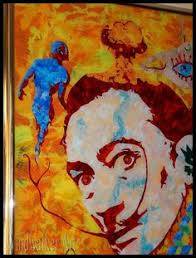By stepping backwards in time one can discover an important part of art history associated with reverse painting on glass. It was an era that heralded the use of this art form 'en masse' during which people in communities could directly express in their own original way what they lived, perceived and felt in their own daily lives. Even to this day many artists who work on glass have been inspired through their links with furniture-making, glass production, the building trade, the teaching profession, or with farming and agriculture.
This painting technique often alludes to reality, seeking it as an accessory rather than as a necessity. Instead it tends to give importance to its symbolic quality.
As well it is an art technique that pertains to the surface rather than one which creates space or depth. In turn (due to an absence of volume) it also creates an absence of light and shade.
Reverse painting is often profusely decorative, possibly an expression of the artist's need to be attentive to ornamentation and detail.
There is quite often a tendency to use direct complimentary colour combinations e.g. orange with blue, or red with green.
Nature is often very present in this unusual painting technique, especially in artworks created by those living in rural farming communities. The simplistic representation of the human form also evolves in such paintings and along with the absence of volume light or shadow creates a totally original aspect to this work by accentuating the difference between realism and naive art in a rather appealing way.
It would not be apt to regard reverse painting on glass as a very simplified form of art expression. Not only does this painting technique require patience and a number of technical skills, it also represents an art form that details and interprets an artist's own personal experiences.
You can read more about the technique of reverse painting on glass on my Reverse Painting blog - http://www.reversepainting.blogspot


